
Is Glee actually bad for gay representation on television? That’s not a question being asked by GLAAD (which loves the show) but Newsweek‘s Ramin Setoodeh, the magazine’s go-to for all things gay. The article isn’t just misinformed, its premise is miserable.
Characters like Glee‘s Kurt, Entourage‘s Lloyd, and Ugly Betty‘s Marc and Justin all lean effeminate, some more than others. This, Setoodeh all but concludes, is “hurting” the image of gay Americans because it’s pushing a stereotype.
He’s right — but only in the “pushing a stereotype” department. Which, let’s be sure, isn’t always a terrible thing. And is sometimes worthwhile.

Setoodeh (pictured), who was previously called out by Project Runway‘s Jack Mackenroth for misinformed entertainment reporting, fails to acknowledge that when it comes to today’s gay television characters, particularly the young ones, we’re in the middle of new era. One of progress. These characters are no longer on the sidelines; they are crucial to the main stories. They aren’t merely the sounding boards for the main protagonists; they are given their own complex plotlines. No longer are these characters prohibited from being as sexual as their straight counterparts (though we’re still not completely there).
How about we take this to the next level?
Our newsletter is like a refreshing cocktail (or mocktail) of LGBTQ+ entertainment and pop culture, served up with a side of eye-candy.
With Glee‘s Kurt and fellow youngster Marshall on United States of Tara, we’re seeing gay teen characters who deal with school pressures, crushes, and coming out. They also just happen to be characters who play fey. And that’s okay — because many young gay kids (and adults) are.
Moving up the age spectrum are Entourage‘s Lloyd and Nurse Jackie‘s Mohammed. They can both queen out, sure. But the importance of Lloyd — whose relationship was part of the plot — continues to grow on the HBO series. Aside from Jackie, Mohammed might be our favorite character on Showtime’s drug drama, because he is witty, not “sassy.” And the gay parents on Modern Family might lean feminine, but where’s the recognition that they are breaking down stereotypes by starting a family, instead of remaining thirtysomething and fabulous?
And did Setoodeh forget all the non-girl-y gay male characters on the small screen? Because they’re everywhere: Trauma, Southland, Brothers & Sisters, Greek, One Life to Live, and Torchwood. Heaven forbid they promote another stereotype about gay men we’ve encountered: Some are masculine and — gasp — “straight acting!”
For once, we’re volunteering to let GLAAD give a media outlet a smack down. As GLAAD chief Jarrett Barrios has said about Glee‘s Kurt: “To see a story line that reflects the anxiety that they have, and for that character to get reinforcement that being gay isn’t an illness or a perversion, that kind of message is extraordinarily powerful.”
Unfortunately, so too are completely off-base articles in well-respected national magazines. This has all the markings of a story that began “Hey look, there’s a trend!,” which always end badly.
Setoodeh isn’t all bad; he penned this cover story about Lawrence King and the troubles facing gay youth. We believe his heart is in the right place, even as an “objective” entertainment reporter. But there’s something terribly off base with a conclusion that it’s bad to finally have young gay television characters that real-life gay kids can identify with.



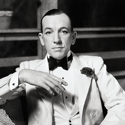
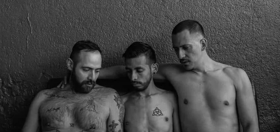

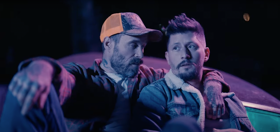
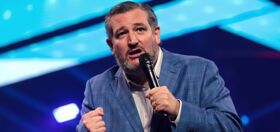


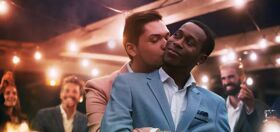

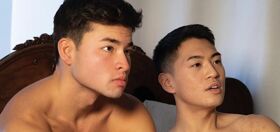




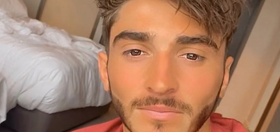
Mr. Enemabag Jones
Setoodeh is a douchebag.
I–like many here–know lots of femme queers. They are real and exist. Setoodeh is confusing flamboyance with effeminacy. I don’t really like guys who act flamboyant simply to draw attention to themselves, but I don’t hate guys who queen out just for fun. My BF is femme–think a 30 year old Justin–and frankly I’m happy to see femme characters on TV. The butch ubber-gays were getting tiring.
Qjersey
It’s always the uptight white boys who were shut tightly in the closet during high school and perhaps college that have issues with those of us who are “identifiably queer.”
I was half out in high school… not out to my classmates, but out to everyone else after 3pm after school was over (in the early 1980’s mind you!)
So I just love Justin, Kurt and Marshall. I probably would have been more like them if I was a teenager today.
reluctantcommenter
yeah Qjersey, it’s always the uptight white boys…except ramin setoodeh is iranian and likely doesn’t identify as caucasian. i think your prejudice is showing.
GeoffM
I love these characters! I have more of a prob with the story lines on Glee….which I think are bad news plain and simple. (a teacher blackmailing a student w/planted marijuana, marijuana in the brownies at the school bake sale, lying to another student about a pregnancy that isn’t his and treating him like crap…the list goes on)
Andrew
The real problem with the article is the author wonders if effeminate gays actually contributed to the losses of same-sex marriage in CA and Maine. Amazing ignorance.
He also claims: “Marriage (and the military) are sacred institutions, so it’s not surprising that some heterosexuals will defend them against what they see as a radical alteration.”
Marriage and the military are “sacred institutions?”
Incredibly ignorant.
Yeah, we need to extend the “perception” of “gay” to include all types – but, the article mostly does the whole “idea” of gay a dis-service – implying we need to be cautious about too much “unflattering” gay.
Perhaps, the biggest problem in the LGBT Community is the lack of any effort to re-brand “gay.” After 2,000 years of being defined as wrong, defective or deviant – all we ever do is react or complain. Especially GLAAD. They simply react to homophobic events and do nothing about re-defining us. For $35 million a year – GLAAD is a big failure. We don’t need media cops, we need some creativity.
Mark
As a big sissy myself, i couldn’t agree more!
Eric
I have no problem with any of this, except for calling Marshall from The United States of Tara “fey”.
Cinci Chris
I think it’s great that more queers are making their way into the mainstream media, but it does annoy me how almost every gay character has to be super queeny. Whether we like it or not, that turns people away when we live in a masculine culture. And in a time when we need people to be coming to our side with support, stereotyping all gay men as flamboyant is not going to help the cause as much as demonstrating that gay men can be “just like you.”
Timothy
“Setoodeh isn’t all bad; he penned this cover story about Lawrence King and the troubles facing gay youth.”
NO NO NO NO NO NO NO
Read it closer. This is an attack piece on Lawrence King.
Setoodeh went to Oxnard, spoke with the Defense Attorney, found an anti-gay teacher, and repeated what they said. He claimed that King “flaunted his sexuality and wielded it like a weapon” and portrayed his killer as
The villains in Setoodeh’s trumped up nonsense is the gay teacher who tried to protect and advise King and the group home who encouraged him to be himself. Setoodeh trotted out the “agenda” word to define the teacher because “she kept a picture of her partner on her desk that some students saw”.
And as for the killer, he was “terrorized” by King. He was just a poor kid who knew about Hitler because of the History Channel, not because he was a white supremest.
Setoodah is probably gay. I suspect he’s an effeminate queen.
But he’s the kind who is ashamed of himself, ashamed of his community, and ready and willing to find any fault and exaggerate it.
It is not characters like “Kirk” and “Marc St. James” that are a danger to our community. It’s people like Ramin Setoodeh.
Sydney
I think it’s great, but I hate when they make gay men TOO feminine. I’ve never seen an episode of Ugly Betty and I HATE Glee, so I can’t say anything about these shows, haha.
Jon
Ramin Setoodeh = right wing tool.
Yuki
I think we need more visibility for the less fey gay people in television. Yeah, we have some, and there ARE people like that, but I think at this point it’s a bit more important to emphasize that gay guys aren’t solely feminine and queeny.
I do like Glee, and not just because of the music and writing; it’s good to have a show that breaks stereotypes. While Kurt is definitely fey, Finn isn’t; while he’s straight, he’s in a stereotypically gay club.
As for Justin… well, the newest episode of Ugly Betty has him say that he’s not gay. While if that’s the truth is yet to be seen… I’m not so sure he belongs in this article.
FakeName
“Ramin Setoodeh = right wing tool.”
Hey, my anagram generator didn’t find that one!
http://www.easypeasy.com/anagrams/results.php
Mick
I’m actually sick of listening to gay men spew crap about gays who aren’t straight acting, making effeminate gays into bad guys.
Let’s be real about this. “Fey” or easily identifiable queer boys pop out that way. It’s not an act. It’s who they are. They are the ones who get beaten up and killed.
It’s fine to show a diversity of queer guys but trying make the more straight acting ones into an ideal is wrong.
holla
@Mick, this may be one of the sweetest comments I have ever seen on Queerty. Good on you.
jason
When you see a lot of camp guys with indeterminate sexuality, it suggests the media is using camp as a source of silly entertainment. It’s pandering to the “give me a flamboyant stereotype to make me feel safe” mentality of liberals and conservatives alike.
Ultimately, it’s a case of the media being homophobic and pandering to homophobes.
jason
Mick,
No, I think anybody who is perceived to be gay is potentially the victim of gay-bashers. It’s not just camp guys. A macho man with a beard might be considered gay by homophobes, and thus attacked.
jason
Ramin Setoodeh is correct. When you see a lot of camp male stereotypes but see nothing of their sexual interactions with other men, it IS homophobic. The media is using camp to replace the sexual interaction. Camp, which is easily digestible by the homophobic masses, thus comes to define us. We are being defined by homophobes.
Alexa
Setoodeh’s a pathetic self loathing idiot, so this irresponsible article does not surprise me at all. Why Newsweek employs him is beyond me.
BobP
Do we have any video of the author when he was 13?
Attmay
@ 14 Mick:
“I’m actually sick of listening to gay men spew crap about gays who aren’t straight acting, making effeminate gays into bad guys.”
Nice straw man argument. Ray Bolger would be proud.
There’s no such thing as “straight acting.” Masculine gays are not “straight” and not “acting.” That’s almost like calling black people who don’t shuck and jive (Obama, for instance) “acting white”. Why is it that whenever we complain about the oppressive stereotypes of gay men as unmanly, whether based in reality or not (and always applied unfairly to the rest of us), we are goaded into tolerating them, while that same tolerance is never extended to us? We are not the bad guys here just because we fit into (most) societal norms about our gender.
I can’t wait for the argument that black TV characters who are shiftless and lazy are good for increasing black visibility. Or Jewish TV characters who are conniving and greedy. Or Asian characters who are super-intelligent with shrill mothers. Or Hispanics who sleep all day. Let’s just stop trying to create multi-dimensional characters. I refused to watch “Will & Grace”, “Queer as Folk” and “Queer Eye For the [inaccurate term for heterosexual] Guy” because of the embarrassing stereotypes. Sal on “Mad Men” was by far my least favorite character, but I yelled anti-hetero slurs at Don Draper for firing him. But that was 1963, and this is the 21st century.
Norman Lear was ahead of current television in 1971 when one of Archie Bunker’s bar buddies turned out to be gay while the Meathead’s nelly hippie friend was not. And this was nearly 40 years ago. When Nixon was president. And sodomy laws were constitutional. Even the one-off gay characters on Very Special Episodes of TV sitcoms in the 1970s and 1980s were ahead of current TV. Jodie Dallas on “Soap”, which has been off the air since 1981, started out as a stereotype, but when he lost those characteristics (about a month into the show) he became much more interesting. And his boyfriend was a closeted football player. The same producers later did “Golden Girls,” whose one-shot gay characters, like Dorothy’s lesbian friend Jean and Blanche’s brother Clayton, were usually the opposite of stereotypes. If we were truly going forward, all types of gays would be shown on TV. But I’ve had an aversion to about 99% of the stuff from the past 15 years.
As for “Glee”, I’ve never even seen the show and I’m already sick of the hype. When I heard they did a story line about an older gay guy who preys on a teenage boy (look at all those stereotypes we’re “breaking”! Aren’t we brave!) I vowed not to support them in any way. It sounds like a “Fame” rip-off to me, anyway. I only saw “Ugly Betty” once and I thought it was okay. I wouldn’t go out of my way to watch it or avoid it.
To let you know where I’m coming from, I don’t mind men who are sensitive, shy, and soft-spoken. I don’t even mind if they cry when things are sad. But sensitivity (as opposed to weakness) is not effeminacy. To be gay, the only thing you have to do is be attracted to the same gender. Nothing else. If you flaming queens want tolerance maybe you should try showing the rest of us some in return first.
Masculine gay men are a lot harder for the breeders to attack. And not just because we fight back.
@Qjersey: Your racism is showing. “Uptight white boys”, indeed! Do the acolytes of Louis Farrakhan troll this board?
David Ehrenstein
http://fablog.ehrensteinland.com/2009/11/15/setoodeh-and-teh-ghey/
sam
@Jason, its safe to say Ugly Betty/Glee makers are not a bunch of homophobes.
As this article says, there are plenty of ‘butch’ gay guys as well (The term straight acting making absolutely no sense for an out gay person). Hell, look back to the nineties, there was an ostensibly butch gay cheerleader ffs in Bring It On. There’s plenty of variation, but it just so happens the most high profile gay characters are effeminate, perhaps becaused theyre in shows about a music club and fashion…Just a thought
Mick
Jason,
Yes. I understand that all kinds of gay men are killed. But, there is a particular dislike for more easily discernible queer boys.
Moreover, slapping the label “camp” on them is disgusting. They aren’t acting campy. They don’t pop out of the womb acting “camp”; that’s who they are.
As for the stereotype of campy, sexually undefinable men. Get real. We’re talking about characters that are gay and men who are gay in real life.
Every time I look at gay media, there’s all this straight acting, or straight male, obsessive lust and tons of anti femme rhetoric. It’s pathetic. It would be like reading about African-Americans praising light-skinned blacks and shunning darker-skinned blacks as the norm.
The scumbag Newsweek author tried to blame Prop 8 and the Maine marriage debacles on “fey” queer boys on TV. What a nice way of blaming gay people for the prejudices and hatred of others!
Hey, we wouldn’t want to say that bigots actually own their hatred. In a different age, I’m sure the Newsweek author would blame a rape victim or a black lynching victim for their rape or murder! Looking at his logic, why not blame Jewish Holocaust victims for their fate for being too Jewish. Had they been more gentile looking, acting, sounding then their killers would have left them alone.
Right? Wrong! This is just victim blaming and making excuses for oppressors.
What a dirtbag! Shame on Newsweek for publishing such trash.
BTW, if marriage is so sacred, why do so many GOP and religious zealots have multiple partners and commit adultery like most people eat potato chips? Randall Terry, Newt Gingrich, etc. All are adulterers with multiple wives. Their marriage vows meant nothing to them.
Yuki
@Mick,
I believe what we’re trying to say is that while there most definitely ARE people who are fey (or “camp” or “feminine” or whatever term is used to mean what it does) and those people can be great to know, we want people to know that not every gay person is like that. While it’s good to acknowledge that there are people out there like that, if we don’t have more gay characters who don’t act like stereotypes, then the stereotypes will be reinforced rather than shattered, if that makes sense.
Mick
Yuki,
I think you’re missing the point of the article and my comment. The article states that the reason why Prop 8 passed was because of the presence of effeminate gay boys/men. The article, in essence, laments the portrayal of less masculine gay men.
I specifically stated that there are a spectrum of gay men; however, in gay culture, less masculine men, are repeatedly demonized. Get it? I’m all for presenting more masculine gay men. I’m just not for putting them on a pedestal, which the author and many in the gay community do.
That seems to be nothing more than homophobia, external and internal.
Again, the closest analogy that comes to mind would be non-whites extolling members of their group for having white features.
There are lots and lots of little queer boys who are beaten up for being sissies because of their natural tendencies.
Attmay
@24 Mick:
“Every time I look at gay media, there’s all this straight acting, or straight male, obsessive lust and tons of anti femme rhetoric. It’s pathetic. It would be like reading about African-Americans praising light-skinned blacks and shunning darker-skinned blacks as the norm.”
That is the worst and most offensive analogy I have ever heard. Race, which you are born with, is not the same as mannerisms.
@18 Jason:
“When you see a lot of camp male stereotypes but see nothing of their sexual interactions with other men, it IS homophobic. The media is using camp to replace the sexual interaction. Camp, which is easily digestible by the homophobic masses, thus comes to define us. We are being defined by homophobes.”
You win the thread. I am really fed up with camp. It’s become nothing more than an a buzz word to justify garishness, stereotypes, and bad acting.
WillBFair
I think Jason and Mick are so right.
Queers are bigotted against queens. And it must stop.
And the media is coopting camp for their own sleazy purposes. I actually predicted this on my blog, in the essay Gay Culture Back In The Closet. But it’s depressing to see it happening.
scott ny'er
@ sam
As this article says, there are plenty of ‘butch’ gay guys as well (The term straight acting making absolutely no sense for an out gay person). Hell, look back to the nineties, there was an ostensibly butch gay cheerleader ffs in Bring It On. There’s plenty of variation, but it just so happens the most high profile gay characters are effeminate, perhaps becaused theyre in shows about a music club and fashion…Just a thought
=======
but that’s saying because they’re in a music club/fashion shows the characters should be effeminate. And what’s funny about that is the dude who’s the teacher is a Broadway star and NOT effeminate. He’s not gay either. Let’s try and break these stupid stereotypes. Sure there are effeminate gay dudes in theater and fashion BUT there are non-effeminate gay dudes as well and it would be nice to see that they exist and show the world we’re not all just effeminate dudes.
i dislike Glee because it’s full of stereotypes and the minority characters have limited screen time. The sassy black singer with a big voice, the asian who doesn’t speak, the effeminate gay dude. And all the stories are about the cute, white, hunky boy and the pretty girl. Zzzzzzzzzzzzz. So not diverse.
Jamie
If you think the gay cheerleader from Bring it On was butch then you have no clue what ‘butch’ is.
There’s currently only one butch gay character I’ve seen on tv this season and that’s the character Riley on the teen primetime soap Degrassi.
He’s the only one.
You’d think we were a rarity or didn’t exist and all gay men are feminine.
The femininity is a stereotype that was used to humiliate and demean us on film and off for a very long time. Sure some chose to embrace it and turn it around, which is fine, but to pretend it’s anything more than blackface to the mainstream media is just idiotic.
We’re being made fun of, not embraced. They take our power away so they can feel comfortable. Masculinity is competition, taking ours away means we’re no longer competition. As men we are all alpha males and they’re just trying to find ways to diminish us so they can feel better than someone.
The fact of the matter is there are more overly masculine gay men than overly feminine gay men. On both sides of the spectrum we take extremes because straight men have been playing with our minds for so long.
I’m not saying anyone has to be masculine, but that feminine only image is presented as the only image the majority of the time.
Why can’t there be both a masculine gay image and a feminine gay image at the same time? Are we not allowed to coexist? Do I cease to exist when your presence is near?
Robert, NYC
Truly amazing how some gays are against the effeminate type of gay male. They have short memories, many of those types were the ones that heralded the beginning of the gay rights movement around the world beginning with Stonewall. They had the guts and the courage to stand up against bigotry and look what it unleashed. If it weren’t for them, we might all still be hiding in the closet.
Stereotyping us is down to the breeders which proves they don’t know any gay people and that’s our job, to make sure they do.
nonotreally
How is not wanting feminine gay males being the only gay males represented the same as being against feminine gay males in general?
Maybe you should chill out long enough to see that there’s a large group of us who go ignored.
Don’t be so self-centered.
Al
The general fallacy with this article AND any others that try to dissect representations, particularly of gay men and lesbians on television is that we automatically assume a dichotomy that can definitively differentiate a “good” stereotype from a “bad” one. The problem with doing so is that there is no monolithic gay man, just as there is no monolithic black woman, Hispanic teen, etc. as such, we have to take these characters at face value. Is Kurt (on Glee) a more feminine character, sure, but there are hundreds of gay youth who may identify with him. He also fails to mention what could be considered more “gay positive” representations like the one on Brothers & Sisters which features a very domesticated gay couple who are in the process of trying to conceive a child through a surrogate. In addition, Modern Family also features a gay male couple who have adopted a child. Certainly these two examples are not perfect, particularly when you consider the relative absence of displays of affection when compared against the other characters on the show. Gay men and women cannot look to a single television character to be all things to all people — that, I believe is the fallacy.
Yuki
“How is not wanting feminine gay males being the only gay males represented the same as being against feminine gay males in general?”
This, completely.
Mick
Attmay,
You’re an idiot! Being effeminate is NOT a learned behavior for most people!
Are you stupid and ignorant enough that little boys who are called queer, sissy, etc. from early in life aren’t targeted because of their innate behavior?
What? Do you think there’s a class that 4 year old take to be sissies?
Attmay
@35 Mick,
Maybe it’s not necessarily “learned” as in taught in school, but it it’s still not analogous to skin color, and you’re the idiot, as well as a racist and an asshole. As is anyone who defends the flaming queens.
@31 Robert NYC:
You need to do better than invoking Stonewall.
@30 Jamie:
“The femininity is a stereotype that was used to humiliate and demean us on film and off for a very long time. Sure some chose to embrace it and turn it around, which is fine, but to pretend it’s anything more than blackface to the mainstream media is just idiotic.
We’re being made fun of, not embraced. They take our power away so they can feel comfortable. Masculinity is competition, taking ours away means we’re no longer competition. As men we are all alpha males and they’re just trying to find ways to diminish us so they can feel better than someone.”
You tie for the win on the thread. This is 2009, almost a new decade, and we’re still in “The Boys in the Band” territory. If you recall, that play opened in 1968 and the film came out a year later. And even then not all of them were nelly (the character played by that actor who later became Lucille Ball’s son-in-law, for instance, was not only masculine but wanted monogamy from his boyfriend who wanted to sow his oats). And the effeminate main character, Michael, who owned the apartment where the action took place, was a complete asshole. He must be a role model for many of the commenters here.
As for effeminacy itself, I know no women anywhere who act like gay men. But I know plenty of hetero guys (it’s not them as individuals I hate, it’s their sexuality) who are basically butch lesbians in men’s bodies.
We don’t have to be crude caricatures of masculinity like the Village People. But I’d rather be one of them than Richard Simmons; for one thing I’d get a check every time a sporting event played “YMCA” or one of the Cinemax sub-channels dared to show “Can’t Stop the Music”.
But what do we all think about butch lesbians?
Ron
Fem gays guys are the Step and Fetchits of the media world. They make straight men comfortable because they are non-threatening eunuchs. Sure, there may be some innate feminancy that gays are born with, but at some point, it is clearly a decision to “play it up” for attention’s sake. I have met many a fem gay, but I’ve never met ONE who didn’t consciously “turn it up” for attention.
sunners
@Jamie
“There’s currently only one butch gay character I’ve seen on tv this season and that’s the character Riley on the teen primetime soap Degrassi.
He’s the only one.”
Sure, Riley is the definition of butch, but he’s also pretty obviously self-hating. I know the character is 16 or something, so some confusion/hesitance/fear about coming out is fitting, but Riley extends it to the point of violence when another (gay) character casually asks if he’s also gay.
And while I don’t watch Brothers & Sisters or Modern Family, I’d argue that Calvin, on Greek, is butch as well. His boyfriend, Grant, is pretty butch also, although he’s closeted. Calvin’s character and sexuality are central to the series’ plot – and Calvin’s character is not only a strong, positive example (and influence on the other characters) of a gay character (who is at peace with his orientation, rather than Riley’s conflicted status), but he’s also a gay man of color. On a Disney-owned network show.
Just thought it was worth mentioning.
alan brickman
Masculine gays are just as likely to be attacked if not more so by insecure hypocrites…gay and straight…
alan brickman
Feys are not progress…just a reminder of the humiliation all gays suffer…
scott ny'er
@sunners
wait. Calvin from Greek has a storyline and is actually in episodes. In the beginning of that series he was in every 4th or 5th episode. Not really a strong presence. And that is college, while Riley is in HS.
Glad to hear he’s butch. What I’d prefer seeing is the Marco/Dylan dynamic. Marco is a little effeminate. Dylan less so. Different shades of gay. Brothers and Sisters does that with Kevin/Scotty. Altho Kevin isn’t really Butch, he’s more your average intellect and Scotty was very flamboyant in the beginning and has now toned it down a lot.
jimmy
In a heterosexist culture, which is ruled by archetypes like, for example, the masculine man symbolizing more power/status, it only stands to reason that those conventions would spill over into gay culture. What does that mean for masculine gay men? Well, for some it seems, it can go to their head, since they are rewarded with a status they we are programmed to give them. They have been able to ‘pass’ in the straight world. Unlike the queeny gay boys who have no choice but to be who they are and suffer for it.
As a defense, those gay boys become entertainers, figuratively if not literally. They purposefully draw attention in order to channel what would otherwise be negative, even hateful sentiment, like that of #40, as a defense mechanism. It comes down to a matter of survival, which is certainly no guarantee in very homophobic places. But, not leaving the house is rarely an option, so what to do? Turn it down? Butch it up?
It’s one thing to be derided from a straight community that is preprogrammed to see you as odd and undesirable, but it must really suck to receive the same derision from those within your own community.
James UK
@ Attmay and Ron and their fellow travellers or should I say kapos:
So gays who are camp are nothing more than the gay equivalent of Step and Fetchit?
Whereas gays who assimilate and can pass for straight in most social situations (unless of course they’re at the bathhouse when such considerations, with the reassurance of numbers, can safely be left with the queen at the coat-check) are, one supposes, the gay equivalent of Malcolm X?
A better description of the stench of the closet would be hard to find.
Queens and dykes are and have been the only representatives of homosexuals and lesbians in modern times because, by choice, they have been the only people to step outside of the closet.
The reason that you have space to whine about how awful queens are, from the supposed mountain top of proud straight appearing homosexuals, is because queens and dykes have gifted that space to you.
You seem to think that there is a huge distance between you and the queen whom you find so contemptible. There isn’t. The real distance between you and that queen (applying your logic, not mine) is the length of about 2 or 3 carriages on the train to Auschwitz.
Apart from disclosing, no doubt unconsciously, the most appalling sexism, your comments reveal your characters as well as your prejudices. You are clearly little boy faggots of the worst sort, for whom the closet is the next best thing to the nipple. If it wasn’t for the dreadful example that you set to the young, I’d be quite happy for you to spend the rest of your life there, being quietly suffocated by the scent of your sensible shoes.
Attmay
@43 James UK:
I am 100% gay and 100% out of the closet. The real “assimilationists” are those like you who marginalize those who do not fit into your narrow view of how gay men and women should act. That is far more repressive than the traditional societal expectations of gender roles.
We are not assimilationists. We are integrationists. We are fighting to integrate homosexuality into the mainstream of American life. We are more of a threat to homophobic bigots because we can seem just like them, while challenging their prejudgement of how a gay person acts. A nelly queen is easy to point out and marginalize as the “other”, and to use as an example to marginalize us. Hate groups send their cameras out to pride parades, not to gay weddings, because they want to marginalize us. What better way to marginalize us than to reinforce stereotypes? I refuse to give them the satisfaction. Just because they were they were front and center at Stonewall doesn’t give them the last word over what is and isn’t acceptable gay behavior. I played with boys’ toys when I was a kid. I left the Barbie dolls for my two younger sisters, who also both play sports and are not gay. I’m gay because I am attracted to M-E-N.
Unlike the increasingly repressive UK (gotta love those security cameras on every corner), the United States is a free country. And I’ll act as I damn well please. I am not “straight” (I hate that word when used to describe breeders) and I am not “acting”. Like the song says, I am what I am. And the fact that you would call me a “kapo”, seeing how I am also Jewish, continues to show what a scumbag you are. No one called for the execution of these people, and obviously no one can stop them from acting that way. But they are an embarrassment to the rest of us, and you prove my point about what hypocrites you are in demanding tolerance for bitchy queens while prattling on with tasteless concentration camp metaphors. Do you still call Americans “colonials”?
BTW, you reveal your ignorance when you say “Step and Fetchit”. Stepin Fetchit was an actual black actor of the 1930s who played a one-dimensional lazy, ignorant and unintelligent stereotype. He made (and lost) a fortune and is considered an embarrassment to many blacks today (if Barack Obama was anything like that he’d never be elected dog catcher, never mind President). He is everything people like Sidney Poitier and Bill Cosby fought to get away from in their careers. Yet there are blacks who consider the likes of Bill Cosby “inauthentically black”; there was even a book by a black author that claimed that The Cosby Show’s success among white audiences was because of white racism. There were blacks in Chicago who believed similar things about Obama. You and yours are the gay equivalents, and perhaps the reason that too many men stay in the closet is because they don’t want to be associated with your blend of cruelty, misogynistic affectations of mannerisms from long-dead Hollywood actresses, and fascism. I suppose underneath every prancing queen lies the heart and soul of Eva Peron.
Robert, NYC
Attmay, be careful. THe fact that the UK uses a lot of cameras on the streets was primarily designed to observe violent crime and capture the perpetrators, which for the most part it does along with other antisocial behavior, has nothing to do with nelly queens flaunting it on the streets.
Socially, the UK is far ahead of us in terms of LGBT rights, no they don’t have full marriage equality yet, but at least they have all the rights of marriage at the national level in the form of civil partnerships. They don’t have to go to any part of the country to get a partnership legalized, every village and town peforms them. They can also adopt children and don’t have to be partnered, they can bring in binational partners to legally reside and work there, we can’t. They also allow their gay citizens to serve openly in the military and there is full protection in the workplace and the delivery of goods and services. What do we have? Five states with only limited marriage equality at the state level and the majority of other states with next to nothing.
Alexa
Agreed, Robert. I’ve spent a lot of time in the UK in recent years, and while it’s not perfect (try being a gay athlete) it’s light years ahead of here. Gays and lesbians, just like any other group, come in all types, all shapes and sizes and how “gay” we appear. Complaining about any one type of gay is pathetic, it drags us all down and makes us appear less than we are. Being an effeminate man or a butch woman is nothing to be ashamed of, or something that should be hidden. Everyone should just be themself.
Robert, NYC
Alexa, thanks, concur with you too, and I wasn’t defending James, UK either. Another thing, though I’m far from being a conservative (republican), at least the UK’s conservative leader is publicly courting the LGBT voting bloc there, so even if they win the election next year and probably will, Britain’s gays won’t have to worry about losing rights or having rights overturned in some states like we have here, its far better there. I can’t name one republican leader doing the same can you? Never going to happen and are we ever on their platform during the conventions? Never, let alone acknowledged.
Robert, NYC
I meant to have said..”Britain’s gays won’t have to worry about losing rights or having any overturned like we have here”, my apologies to the readers.
Attmay
@48 Robert NYC:
“Britain’s gays won’t have to worry about losing rights or having any overturned like we have here”
I’d also like to have freedom of speech as well as equality under the law:
http://www.guardian.co.uk/uk/2006/jan/02/pressandpublishing.gayrights
The English are a great people with a proud history, and they’re hurdling into oblivion.
@46 Alexa:
“Being an effeminate man or a butch woman is nothing to be ashamed of, or something that should be hidden.”
Ironically I have very little problems with butch women. But men who are bitchy and/or flamboyant embarrass me. Andy Dick made “NewsRadio” totally unwatchable for me. My favorite line about Richard Simmons comes from The Great John Waters: “When Divine met Richard Simmons even HE felt homophobic.” I don’t know any women who act like that.
freethinkingelder
Many people seem to be saying that we should fit in, change our identity to something straight people will accept. That’s why there is hardly any gay culture or community left, everybody is trying to appear straight. The ideal is that nobody should have to appear to be anything they’re not, whether it is on a television program or in real life. If it wasn’t for the fey/effeminate there would have been no gay movement because those who followed the dictum of “go along to get along” were getting nowhere. Stonewall didn’t start the gay movement. It simply put it on the map.
Obviously, these characters on these programs have not hurt their ratings. What happened to the diversity in the gay community?
Attmay
@50: notfreethinkingelder:
“What happened to the diversity in the gay community?”
There always has been diversity in the gay community and there always will be, because we are represented in every race, religion, and nationality, and both genders. But the only ones ever shown are of a small number of very narrow types. But the nonwhites are pushed aside, the non-queens are vilified regularly, and anyone who dares challenge the orthodoxy of the leftists we foolishly aligned with is considered an apostate, or worse.
You can control your behavior. That is a fact. One reason homosexuality was ever seen as incompatible with traditional gender roles is because of misogyny. Yet behavior in some males that, in my opinion, is even more misogynistic, is not only to be defended but celebrated?
We were told that being gay made one unmanly. We need to show that not to be the case. When The 700 Club needs another poster child to reinforce the blue-hairs’ prejudices, it will be the humping and bumping queens at “Pride” parades that they go to. They will not be going the wedding of two regular, down-to-earth guys in suburban Iowa. It is those theoretical married Iowan everymen and everywomen who are the true face of gays in America, buried under a grotesque mask of hedonism and political correctness.
When I was questioning my sexuality as an adolescent, it was the gay cultural bias against any form of masculinity in anything other than cartoon form represented by “bears” and the like, not to mention the continued promiscuity that seemed to be celebrated and institutionalized, even after the AIDS crisis (how naïve of me for viewing sex an expression of love between two people). Even when I accepted being gay and came out, I still felt uncomfortable with the gay community embracing and glorifying the bitchy queen. Apparently I’m pure evil for believing you don’t have to act like a caricature of a woman to get a man.
And as for sexism? Mention Hillary Clinton or Sarah Palin in a gay bar and then you’ll see sexism that would make Nicolas Chauvin sick.
Robert, NYC
Attmay #49, …”I’d also like to have freedom of speech as well as equality under the law.”
The recent hate speech laws passed in parliament protects free speech as long as it does NOT INCITE others to commit violent crimes or worse, killing people because of their race, religion, gender or sexual orientation.
In contrast, an airport security worker here on the east coast was arrested for having said that he wants to kill Obama, his case continues. So much for free speech. Why is it that no U.S. citizen is allowed to shout “fire” in a movie theater?
Yes, I want full equality as the next man, but the UK’s equality laws have gone a lot further than ours have. They’ll have full marriage equality before we will at the national level than we here can ever forsee happening in all 50 states. All it needs is a change of terminology, nothing more. Its going to come, sooner rather than later as more European countries get on board, five so far.
Alec
I sort of get annoyed by these characters, because I am those masculine type of gays, don’t get me wrong, I have no issue displaying some femininity whether if it is going to get my co worker to help with my mild acne, who is also an aesthetician. But for the most part I’m masculine, and I do get tired of the excessive need for the effeminate gay man. Maybe it would’t bother me as much if there were less of that, I’ve met more just normal gay men, that you would not know unless they told you, than I have met easily identifiable gay men. I realize that there are really effeminate gay men, but there are also a lot of normal guys who are gay that are just like straight men, except for liking guys rather than girls.
jason
While there are camp gays, it is important to understand that camp and gay are two different words. Each has its own definition. I do think that it’s important to show a spectrum of gay male characters – too much emphasis on the camp gay or the butch gay is not a good thing.
Jacques
The problem is that the gays are so marginal (still!) that any representation of them is, in a way, definitive. We mustn’t have too many camp gay characters, too many butch gay characters, too many promiscuous gay characters, because the result will be that people will come to believe that any of these images represent our community as a whole.
Please consider that nobody would take a narcissistic and sociopathic straight white male character from a show and think, “well, is this sending the right message about what real white heterosexual men are like?”
NO! Of course it doesn’t; it doesn’t send any message. He’s an individual character, and can behave however his script dictates without representing anything other than (enter straight white male character’s name here).
Are characters like Kurt representative of the broader gay community? No. They’re tv characters. Granted, there are many gay people who act that way (myself included, I think), but there is no connection between individual tv characters and the reality of a real and diverse community.
Dennis Battle
@Andrew: Bravo! Well done! Yes we do need greater creativity and less judgement passed upon feminine gay males from dismissive and superior straight-acting gay males. There is no right way to be gay other than the way that is instinctively natural with no affectation of either feminine or masculine expression.
Jack Hopes
For a truly well-done gay teen storyline in recent years, look no further than “United States of Tara”. While there was a similar focus on a crush on a straight boy, it didn’t turn into predatory behavior as on “Glee”. I mean, seriously, setting up the two boys’ parents so Kurt and Finn can be closer?? That’s just psychotic!
http://www.healthproductreviewers.com/extamax-male-enhancement-review.html
Nate
Do t forget about the gay Indian kid from weeds, and were they refuring to nurse Jackie as our favorite showtime drug show, because if so they are sadly mistaken.
Weeds is by far the coolest show on showtime